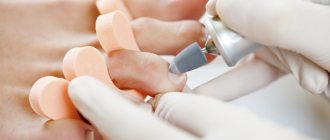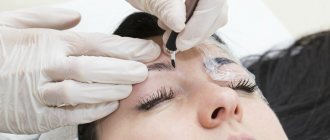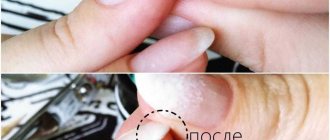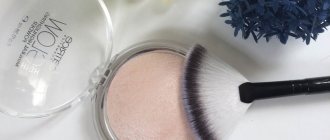Menstruation becomes an integral part of every girl’s life, from adolescence to menopause. And these days come regularly. Using a personal calendar or even a special application on your phone (or other gadget), you can track the frequency of your periods and their duration. Each girl can choose blood absorption products that are suitable specifically for her. Pads, tampons, menstrual cups - there is a wide choice. But most often it is the possible harm of tampons that scares us, and not other means.
Individual choice
Surely every girl will agree that menstruation is an unpleasant and inconvenient phenomenon. But still, this is a signal that the lady is healthy, is of reproductive age and is not currently carrying a child under her heart. If your periods disappear, then pregnancy is the only joyful diagnosis possible. In other cases, this is a signal of illness or gradual decline of the reproductive function of the fair sex. So any girl takes menstruation for granted. She has the power to make these days as comfortable as possible through the chosen hygiene products. At this time, you should often shower and wash your genitals, rest more and, if possible, get enough sleep. Most women choose pads to absorb menstrual blood because of their ease of use, availability and lack of contraindications. But gaskets have significant disadvantages. First of all, this is the risk of leakage. It also has an unpleasant odor that can be noticeable after just a couple of hours of use. And we must not forget that pads can be noticeable under tight-fitting clothes, so during your period you will have to forget about tight trousers and miniskirts. Because of these factors, girls are increasingly “switching” to sanitary tampons during menstruation. Is there any benefit or harm behind this choice? It's worth looking into.

A little history
Speaking about the harm of tampons for women, we need to delve into the past. Then it will become obvious that ladies have been using tampons during their periods for thousands of years. The oldest handwritten medical document, the Ebers Papyrus, describes soft papyrus tampons used by women in ancient Egypt as early as the 15th century BC. Representatives of the fair sex in Rome preferred woolen tampons. It's a little scary to imagine how problematic it was to use them. In Ancient Japan, paper analogues with a bandage were in use. They changed up to 12 times a day. In the Hawaiian Islands, tree ferns were used, and in some areas of Asia and Africa, herbs and moss are still used today as hygiene products.
Russian ethnographer with German roots Jacob Lindenau wrote that Koryak women “put moss tampons between their legs,” taking the example of Ostyak and Tunguska ladies. Such “tampons” were burned every morning, and during heavy menstruation, two or three times a day.
Modern remedy
Almost as it is now, the tampon has been used since the 18th century, when it was used to treat wounds. The first modern version with applicator tubes was patented by doctors Earl Haas and Michael Dahn. Later, Gertrud Tendrich bought the patent rights, and in 1933 she began selling this product. As tampon production increased, Tendrich hired promoters to promote the products in pharmacies in Colorado and Wyoming. She also recruited nurses to give lectures on the benefits of this remedy. They talked in detail about the benefits and harms of tampons for women during menstruation. Back then, such frankness in discussing such a sensitive topic was new.
Taking care of the female anatomy
Towards the end of the 1940s, Dr. Judith Esser Mitta and her husband Kyle Lucerini began developing the world's first tampon without an applicator, which had to be inserted into the vagina with fingers. Soon, doctors Karl Hahn and Hein Mittag launched mass production of such tampons. Thus, women all over the world have a choice when purchasing this hygiene product. Almost forty years later, the question has arisen about how much harm tampons cause to women due to cases of toxic shock syndrome.
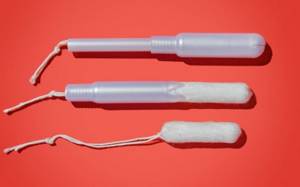
Harm from tampons for women during menstruation
It is difficult to imagine a modern woman who never uses gynecological tampons. For some reason, we have a misconception that they were invented in the last century. In fact, they were used by the ancient Egyptians 25 centuries ago. Now the technology for manufacturing these hygiene products is completely different and papyrus is no longer used.
It is difficult for a young girl to figure out whether tampons are harmful during menstruation. There are many opinions on this matter, both false and true. Let's look at all the nuances of this issue in order to understand when tampons can be used and when they can harm the body.
Modern gynecological tampons
Even 20 years ago, tampons and periods were talked about bashfully, so that no one would hear. Now this product can be found in pharmacies and on store shelves. Everyone knows what they look like, but not everyone knows how to use them correctly.
A cylindrical object is inserted into the vagina, and then, after a few hours, it is removed using a thread, which is part of the structure. Its composition is dominated by cotton or cellulose (viscose).
Answering the question about why tampons are harmful during menstrual periods, it is worth noting the dishonesty of some manufacturers. A hygiene product is sometimes impregnated with various liquids to give it color, smell or desired properties. These substances can have a bad effect on the vaginal microflora, which leads to certain negative consequences.
The harm comes more from the manufacturer who decided to save on production. Modern tampons for menstruation are often impregnated with various essential oils and other plant components to which a woman may be individually allergic.
Pros and cons
Let's take a closer look at the pros and cons of tampons in order to understand the existing risks. Let's start with the positive aspects.
- Does not cause discomfort during insertion and removal.
- Hides under clothes and does not stick out like a pad. Can be worn with any clothes.
- Movements are not restricted in any way; you can sit in any position and run.
- Compact and takes up little space in your purse.
- Menstrual flow does not come out, but is absorbed by cotton or viscose. Even when expanding due to discharge, it does not cause discomfort.
- Blood does not come into contact with air, so the characteristic odor does not appear.
The harm and benefits of tampons are very ambiguous concepts, because they depend on many factors. Often the same hygiene products can have different effects on two girls.
Now let's look at some negative points:
- not recommended for use by girls in the first year of menstruation;
- Toxic substances may be used in the composition of the hygiene product;
- There are cases of toxic shock syndrome;
- an incorrectly selected tampon for menstruation is dangerous due to problems with the absorption of discharge;
- if you forget to change your hygiene product on time (women sometimes don’t notice it and forget), then this is fraught with negative consequences for the body.
Where does the real harm lie?
This is not a panacea, so it’s worth talking in detail about the dangers of tampons for women during menstruation.
Why has this topic become relevant only now, since tampons have been used for thousands of years? This product has become widespread and accessible to everyone.
In addition, over a couple of decades, production technologies have undergone significant changes, and the chemical industry helps reduce the cost of any product by replacing natural elements.
The first danger lies in the materials from which hygiene products are made.
If cotton is used, then there is nothing to fear. Although opponents of genetic modification claim that the producers do not use natural cotton. It is believed that genetically modified cotton reduces the susceptibility of a woman's reproductive organs to antibiotics. As a result, treatment of bacterial diseases becomes less effective.
Viscose, used for better absorption of menstruation, contains many chemical compounds. It is difficult to predict what reaction might be to such components.
When dioxin is included in a gynecological hygiene product, the question of whether tampons are harmful for women during menstruation should disappear on its own. Dioxin is used to give the product a white color, because then it sells better.
Dioxins have a carcinogenic effect on the body and are also responsible for artificial suppression of the immune system. They accumulate in a woman’s body, because they are extremely difficult to break down. It is believed that one of the causes of endometriosis is the use of dioxins. The lethal dose of the substance is 10-6 g (one millionth) per 1 kg of weight.
Menstrual blood accumulates in the tampon and is found in the girl’s body. Various microbes and bacteria begin to multiply in the blood, which is not very good.
Toxic shock syndrome
Separately, I would like to dwell on such a disturbing concept in women’s minds as toxic shock syndrome (TSS). When people talk about why tampons are bad, they often talk about the dangers of TSS. The concept arose about 30 years ago. The reason for the panic lay in the rapid proliferation of bacteria due to the use of tampons during menstruation.
Women began to encounter this problem because they used hygiene products incorrectly or suffered from various inflammatory diseases.
Staphylococcus, streptococcus and clostridia are microbes that are present in small quantities on the human body. However, they begin to actively reproduce if a woman does not change her tampon for a long time during menstruation. As a result, the following symptoms appear:
- dizziness;
- convulsions;
- vomit;
- heat;
- rash.
These syndromes require immediate medical attention and should not wait until your period has passed. They develop and intensify very quickly.
How to use tampons correctly
Having studied the dangers of tampons, you can easily guess that very often problems arise through the fault of the girl herself. Many problems can be avoided if you are careful and follow all instructions.
First, you need to choose a hygiene product with the correct absorption of menstrual discharge. The level of absorption is indicated by the droplets on the packaging.
- If there are 1-2 droplets, then the hygiene product is used for scanty discharge.
- Three drops indicate the need to use the product with a normal volume of discharge.
- If there are 4-5 drops on the package, then you need to use the product if there is heavy discharge.
The instructions and composition speak volumes. If the composition contains harmful and dubious substances, then it is better to refuse the purchase, no matter how cheap such hygiene products are offered. Read the instructions and follow them. Standard rules for using tampons during menstruation are:
- It is necessary to wash your hands before and after using a hygiene product;
- if necessary, after changing the tampon, washing is carried out;
- in the first days of the cycle there is heavy discharge, so it is recommended to use a tampon together with a pad (just in case) or only pads;
- To protect yourself from bacterial growth, you need to change your hygiene product every 2-4 hours. This time is approximate and depends on the volume of discharge. Is it harmful to use tampons longer? Yes, the more time they are not changed, the more dangerous the situation becomes.
If you regularly use tampons during menstruation, they can begin to irritate the vaginal mucosa, which causes dryness in the intimate area. Therefore, it is recommended to simultaneously use pads during menstruation to give your intimate area a rest.
Dispelling myths
- The tampon can get lost and harm the body. This is not true, because there is a special cord that you can always pull. It is securely attached so it won't come off. Nothing will penetrate the uterus either, since the passage is too small for this.
- After childbirth, you should only use pads. Tampons do no harm during menstruation after childbirth, but they simply may not cope with the heavy discharge that occurs in women after childbirth.
- If you do not use pads at night, it will harm your body.
This is not true, because at night they become a salvation for any woman. - The period in the vagina will be blocked as blood will not be able to flow out. If the hygiene product absorbs as much blood as it can, it will begin to leak. So the harm of tampons in this situation is clearly exaggerated.
- It can damage the hymen. Research has proven that damaging the hymen with a tampon is only possible if this is done deliberately and persistently, and even then not everyone will succeed. The hymen will not break accidentally .
- You can rub the cervix, causing irritation. Scientific research has confirmed that this is impossible.
When is the best time to stop using tampons?
Even if you choose an intimate hygiene product ideally and use it correctly, it is not always worth doing this. There are situations when tampons cannot be used:
- before and after menstruation to absorb normal discharge;
- vaginal dryness appeared;
- due to the special shape of the hymen, a gynecologist may recommend using only pads until the beginning of sexual activity;
- the body is prone to allergic reactions;
- tampons during menstruation are harmful when a woman has inflammatory processes in the reproductive organs.
Source: https://kapelki.net/gigiena/vred-tamponov.html
Features of the hygiene product
A tampon is an elongated, tightly compressed hygienic absorbent material with a string tied to the end. Using this thread it is convenient to remove it from the vagina. Accordingly, to use the tampon must be inserted inside. This is quite simple to do, but some manufacturers simplify the task by producing tampons with an applicator. The tampon reliably blocks the flow of blood outward and absorbs it inside. Products differ according to the abundance of discharge. The smallest ones are suitable for girls who are not sexually active or have a very meager volume of menstrual blood. If tampons are labeled regular or normal, then they can be used for moderate discharge. Super and super plus tampons are designed for medium to heavy discharge. On each package of products, manufacturers provide information about the rules of use and describe the possible harm from using tampons. This is usually information about toxic shock syndrome.
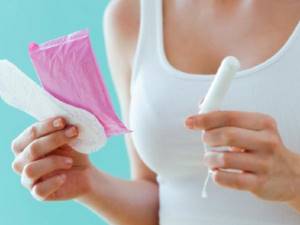
Using tampons. How to use tampons for girls and women
Menstruation used to cause a lot of problems for women. Later, thanks to the invention of such special hygiene products as pads and tampons, “critical days” became more comfortable. However, if using the former everything is extremely simple, then questions often arise regarding the use of tampons. To avoid unpleasant consequences and the development of serious diseases such as cervical erosion, it is worth knowing how to use tampons. When used correctly, the hygiene product is absolutely safe for health.
What is a tampon
This is a small “bundle” of compressed cotton and viscose that perfectly absorbs blood during menstruation. The tampon is placed inside the vagina, so that the discharge does not leak out. They will be held back by the sponge-like texture of the material. Are tampons harmful? Many girls are afraid to use them because they are sure that such products interfere with the normal flow of blood. However, studies of well-known brands (Kotex, Tampax, Ob, etc.) prove the opposite. When the cylinder is completely saturated with secretions, moisture begins to flow through it.
Another common myth about the dangers of tampons is the danger they pose to the vaginal flora. Some believe that daily use of such hygiene products is fraught with toxic shock and the development of cervical erosion. The likelihood of such a scenario is extremely low. Research shows that pathologies can occur if you select and insert a tampon incorrectly. As a result, microcracks in the organ mucosa may occur, opening paths for harmful bacteria.
How to choose the right hygiene product
Gynecologists agree that they should give preference to better-known brands of tampons, avoiding “miracle” Chinese remedies. In addition, their price is not inflated compared to goods of unknown origin. The packaging of a quality product contains a detailed description and certification information. Considering the degree of benefit and the low likelihood of harm from tampons, modern girls can safely use them. With proper selection and use, hygiene products will become convenient and indispensable during menstruation.
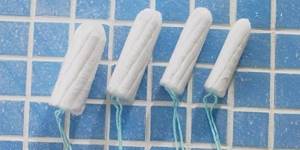
Tampon sizes
Like pads, tampons vary in size. They are indicated depending on the volume of discharge they are designed for. The level of absorption is indicated on the packaging by the number of droplets. The smallest size is 1-2 drops. Even a teenage girl or a girl with light menstruation can use them. Cotton cylinders of 3 drops or more are the best option for women who produce large quantities of blood. Some brands, for example, Obi, indicate the amount of absorption as follows:
- Mini (recommended for girls with light discharge);
- Normal (suitable for girls with slight/moderate discharge);
- Super (used for heavy menstruation);
- Super plus (the best option for very heavy bleeding).
Many women do not always use the same ones, but purchase several types of tampons at once, using products with the appropriate level of protection during different periods of menstruation. For example, if the first days of menstruation are characterized by heavy discharge, they use tampons with 3-4 drops. Afterwards, when the bleeding is not so strong, girls switch to products with a lower degree of absorption (1-2 drops or Mini).
How to insert a tampon: instructions for use
The question interests many young girls who have recently faced the need to use them. No health problems will arise if the cotton cylinder is used correctly. Menstruation is a natural process, and every woman must decide which hygiene product is best for her. Below are tips on how to use a tampon correctly.
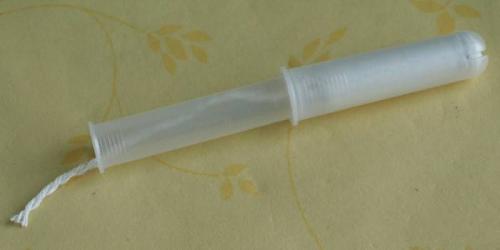
With applicator
- The first thing you need to do is wash your hands with soap. Then choose a comfortable position for yourself to insert the applicator into the vagina. Different girls have their own decisions about tampons and how to insert them correctly. Some squat down, others place one leg on a small hill.
- How to insert a tampon to minimize discomfort? To do this, try to relax your stomach as much as possible. Grip the applicator with two fingers where the wide part begins to taper. Gently push the free end of the tampon into the vagina.
- How deep to insert? It should be inserted until the fingers holding the cylinder touch the perineum. Then press your index finger on the free narrow edge of the applicator, pushing the tampon completely inside the wide part. She is already in the vagina. You will place the hygiene product at the desired depth and minimize the risk of it falling out.
- The final stage is removing the applicator. The string that remains outside will help you pull out the tampon to replace it with a new one.
Dangerous TSS
So, why is the notorious toxic shock syndrome so scary? And why can tampons cause it? The harm to health in this case is caused by a staphylococcal infection, which is rapidly progressing and difficult to treat. As a result, in 8-16% of cases everything can be fatal. This syndrome occurs quite rarely, but all tampon manufacturers are required to warn women about this possibility in their instructions. Young women under 30 may be at risk. The disease is caused by Staphylococcus aureus, which belongs to the group of saprophytic bacteria that produce toxins dangerous to humans. These bacteria live on the mucous membranes and skin, although in very modest quantities. In many people, the immune system is able to neutralize the toxic effects of these toxins. But if there are too many of them in the body, then an infection develops. At the initial stage it resembles the flu, but it progresses too quickly. A woman needs to urgently call a doctor and be sure to remove the tampon if the manifestation of symptoms is ahead of all imaginable norms. Treatment is carried out only in a hospital using antibacterial drugs and solutions.
Just in case
If you have already used tampons and have not felt any signs of illness, then it is too early to relax. Remember simple preventive measures and then you will not know the harm of tampons. For example, take a break from using these products, alternating them with pads at least every two cycles. It would be good to alternate hygiene products even during one menstruation, for example, use pads at night and tampons during the day. Always select tampons with an appropriate flow rate and change them every four hours. If you feel discomfort after insertion, then you need a tampon with a lesser degree of absorption.
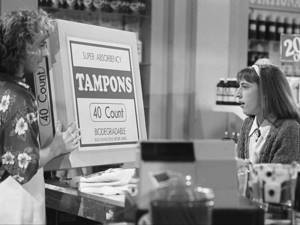
How to choose?
Choosing a tampon is an individual matter. Each woman has her own sensitivity and intensity of discharge, focusing on these indicators, and it is worth choosing a product.
When choosing, you need to pay attention to the degree of absorption, it is indicated on the packaging. You can use several tampons during one menstruation, stronger in the first days, and with medium or moderate absorption in the end. If you decide to try it for the first time, then you should use the “Normal” level. In most cases, they are sufficient, but if the tampon is full before two hours, then you need to take a product with a higher degree of absorption.
In addition, you need to pay attention to the composition. It is better to choose from natural materials, this will significantly reduce the risk of an allergic reaction.
Don’t forget about the physiological characteristics of every woman, so you don’t need to use a product that your friends recommend; it’s best to try it from personal experience and choose it yourself.
pros
Why do many girls choose tampons? The benefits and harms of this hygiene product are of interest to almost every representative of the fair sex who is preparing for menstruation. So, let's look at the positive aspects. When used correctly, tampons are of better quality and more reliable than pads and protect against leakage. They are convenient because they are completely invisible under clothes, which means you don’t have to give up your favorite thongs, shorts and skirts even during menstruation. There is much less irritation on the skin and in the perineum after tampons, since the contact area is smaller. An important plus is the size, which allows you to store a spare tampon in the smallest purse or even pocket. It’s also worth mentioning that tampons make it possible not to deviate one bit from your usual life, that is, to play sports, go to the pool or dance.
Which tampons are better
On the days when a woman menstruates, she is forced to significantly reduce her social activity, and even abandon some activities and processes altogether. But this statement is only partially true and applies only to those ladies who use sanitary pads.
From a health point of view, they are good in that all the fluid is removed from the vagina to the outside, but they are not as comfortable and convenient as tampons, with them you can hardly afford to wear white and tight clothes, but about swimming in a river, pool or sea, you can’t forget.
But tampons, on the contrary, allow a woman, even during her period, not to give up her habits and lead an active lifestyle.
These hygiene products are absolutely invisible to the prying eye, they are comfortable, do not irritate the skin, and reliably protect against leakage, but this is only if the tampons are correctly selected, both in relation to the individual characteristics of the body and in relation to the quality of the material from which they are made.
The main “FOR” in favor of tampons
Although the history of the appearance of the first hygiene products in the form of tampons goes back to the distant past, they appeared on the market in wide access relatively recently, only in the first half of the 20th century in America. And today they have gained enormous popularity among the fairer sex all over the world, since they have made the life of girls during menstrual bleeding much more comfortable.
A tampon is a hygienic product made of absorbent materials, which is inserted into the vaginal cavity and held there by its muscles, but at the same time does not hinder movement at all, protects against leakage and eliminates the sensation of leaking fluid. Agree, this is a huge plus, which cannot be said about gaskets.
Manufacturers of tampons pay special attention to the materials that are used, the absorption capacity of the product, its coating, size, and, of course, the design solution.
Thanks to this approach, the result is a hygiene product that allows women not to limit themselves during menstruation, but to continue to play sports, dance, swim and other active activities, of course, provided they feel well. As you can see, even the best pad is inferior to a tampon.
This product is available to a wide segment of the population, since it is sold in any pharmacies and stores, and is also represented by a large number of manufacturers, and accordingly they have different price positions.
Hygienic tampons are made by pressing from cotton wool, its blends and other high-quality materials. Their first and main difference is the degree of absorption and absorption of liquid. This indicator must be indicated on the product packaging. There are the following markings: mini, normal, super and super plus.
Mini tampons are intended for very young girls who have minimal discharge and no experience of sexual intercourse, that is, the hymen is preserved. Although they can also be used by women who have given birth and whose bleeding is scanty.
The remaining three types are designed for different days of menstruation and their intensity. Therefore, every woman can choose a hygiene product depending on her individual needs.
There are also tampons with and without applicators. Of course, with an applicator it is preferable from a hygiene point of view. After all, a hygiene product without it is inserted into the vagina with your fingers, and they must be perfectly clean; before inserting a tampon, your hands should be washed with soap, but in the modern world this is not always possible.
In addition, some manufacturers offer scented tampons to ladies. But such products must be treated with extreme caution, since allergic reactions may occur, especially in women who are prone to them.
Despite the convenience and comfort, the use of tampons should be limited in time. In no case should you use only them all days of your period. Since such an attitude towards oneself can lead to some complications that no advertisement will tell you about.
Let us devote a few lines to this important point. And so, discharge during menstruation is an ideal environment for the proliferation of pathogenic microbes and infections. Hence, if a tampon is in the vagina for more than four hours, it becomes a breeding ground for germs. The next point is the specific structure of the female genital organs.
The vagina is protected from the external environment by the labia minora. The cervix synthesizes a special secretion that removes blood and mucus after menstruation.
A tampon, on the contrary, is inserted in the opposite direction, therefore, such a violent action against nature can disrupt natural defense mechanisms or cause infection.
Therefore, it is important to choose and use this hygiene product correctly so that it becomes a source of comfort and not complications.
How to choose the right tampons
When choosing a hygiene product, it is necessary to take into account the age and intensity of discharge (they vary both on different days of menstruation and have individual characteristics of the body).
It is important that it is not recommended to use tampons that are too large, they will dry out the vagina and can harm the body, and too small ones are also not recommended, they will not provide the expected protection and will leak.
Therefore, as indicated above, young girls need to choose mini tampons. In women during menopause, the discharge is also not very intense, so the best option would be tampons marked “Normal”.
For women of childbearing age, tampons with different absorption rates are suitable; they should be selected depending on the days of menstruation and the amount of discharge.
But it’s best to start your acquaintance with this hygiene product with normal tampons. And then if it turns out to be insufficiently effective, then turn to other types.
This can be determined simply; if the tampon has leaked in less than three hours, then you should choose a different type of tampon. In general, they need to be changed every four hours.
And at night, use special night pads for protection.
Minuses
Still, there are a number of disadvantages and inconveniences when using these hygiene products. So, tampons need to be changed regularly to prevent the development of infection. Otherwise, there will be serious harm to tampons during menstruation. These products can also dry out the mucous membrane inside the vagina and even cause an allergic reaction. It is not recommended to use tampons at night, as bacteria can actively develop during this time. Due to the need for frequent changes, tampons are more expensive than pads. Another disadvantage will be the limitation in use if there is inflammation of the genital organs.
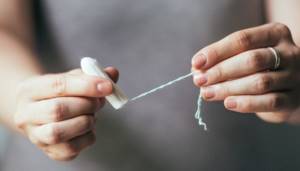
Sanitary napkin
During critical days, special hygiene measures should be observed. The pad should be changed regularly, and hands should be thoroughly washed with soap to avoid infection. Every time you change a pad, you need to wash yourself with warm water and change your underwear. The girl must be taught by her mother how to use sanitary pads correctly.
These hygiene products can have different structures, be with or without wings, differ in thickness and shape, as well as in the amount of moisture absorbed. Some manufacturers add aromatic substances to combat unpleasant odors. It depends only on the woman’s choice which pads are best to use during menstruation. But experts nevertheless compiled their rating and it turned out that the highest quality and most popular are:
- Kotex.
- Libress.
- Olweis.
Nuances
If we consider the possible harm of tampons, we need to clarify how these hygiene products are used. After all, there are enough women who do not bother reading the instructions or at least paying close attention to a product that is new to them. Because of this, annoying incidents and not the most pleasant incidents occur when a tampon is inserted too deep or even lost inside the vagina. How to properly handle this product?
First, change it every three to four hours. Try to do this in the bathroom or toilet so that some of the stagnant blood from the vagina can drain.
Secondly, when changing a tampon, wash your organs and insert a new tampon with clean hands.
Third, handle both the product and your body with care. Too abrupt insertion, as well as abrupt removal, is fraught with microtrauma and irritation. Do not insert the tampon too deep and never tear off the thread necessary to remove it. Otherwise, you will have to get the hygiene product in the doctor’s office.
Fourth, always remove tampons before sexual intercourse. Alas, this basic recommendation is neglected by many girls who do not want to admit their condition to their partner. Such negligence can result in health problems.
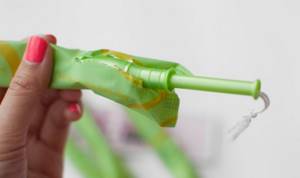
Worth considering
There are also other recommendations from experts that will make the process of using these hygiene products more convenient. To protect against leakage, you can use “daily bags” in tandem with tampons. This way you will be sure that your laundry is clean, because with tampons you can forget about your delicate condition. It is also not recommended to regularly use tampons exclusively. Still, the constant presence of absorbent material inside is not very good for the body. On days of scanty discharge, you can get by with pads. Gynecologists do not recommend using these hygiene products for very young girls without sexual experience. Are tampons harmful to virgins? There are no strict restrictions as such, but a tampon can still damage the hymen.
Tampon rating
When compiling the rating, we considered only the most popular and popularly reviewed women's tampons. Time-tested, experienced manufacturers were given priority. Having decided on the nominees, we distributed the top places according to the following characteristics:
- Dimensions;
- Materials;
- Absorption properties;
- How many drops?
- Ease of use;
- Reliable protection against leaks;
- Duration of use;
- Package;
- Hypoallergenic, likely to irritate;
- Price, manufacturer's reputation.
The result of the comparative analysis was the top of 10 positions. These are 3 nominees for first use by young girls, 3 products with an applicator that simplifies administration, as well as 4 products with a high degree of absorption, which is appropriate for heavy periods.



